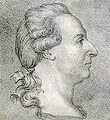Are You Sure? (nonfiction)
Are You Sure? is a feature of the Gnomon Chronicles.
See also Are You Sure? (archive) (nonfiction)
Work in progress
May 2
GNOMON CHRONICLES

Are You Sure ... (May 2, 2020)
• ... that biologist, mathematician, and classics scholar Sir D'Arcy Wentworth Thompson (1860–1948) was a pioneer of mathematical biology; and that his book On Growth and Form (1917) led the way for the scientific explanation of morphogenesis, the process by which patterns are formed in plants and animals; and that Thompson's description of the mathematical beauty of nature stimulated thinkers and artists as diverse as Alan Turing, Henry Moore, Barbara Hepworth, Salvador Dalí, Claude Lévi-Strauss, Jackson Pollock, and Richard Hamilton?
• ... that polymath Athanasius Kircher (1602–1680) was one of the first people to observe microorganisms through a microscope, and that Kircher was ahead of his time in proposing that the plague was caused by an infectious microorganism and in suggesting effective measures to prevent the spread of the disease?
• ... that the deep scattering layer is a layer in the ocean consisting of millions of marine organisms was discovered through sonar, as ships found a layer that scattered the sound and was thus sometimes mistaken for the seabed, and that the layer includes larger numbers of small mesopelagic fish with swimbladders that reflect sonar, and that the layer is deeper when the moon is out, and can become shallower when clouds pass over the moon?
• ... that mathematician, physicist, astronomer, and academic John Winthrop (1714–1779) attempted to explain the great Lisbon earthquake of 1755 as a scientific (rather than religious) phenomenon, and that Winthrop was a pioneer of seismology, applying mathematical computation to earthquake activity?
• ... that Mesopelagium is an oceanographer-run restaurant specializing in seafood from the mesopelagic zone, including bristlemouths, blobfish, bioluminescent jellyfish, giant squid, and a myriad of other unique organisms adapted to live in a low-light environment; and that all of the seafood served in Mesopelagium is raised responsibly in cruelty-free underground aquaculture tanks which provide the high-pressure, low-light environment necessary to culture mesopelagic organisms?
On This Day
GNOMON CHRONICLES
On This Day in History and Fiction: April 18
1796: Physicist Johan Carl Wilcke dies. Wilcke invented the electrophorus, and calculated the latent heat of ice.
1873: Chemist and academic Justus von Liebig dies. Von Liebeg made pioneering contributions to organic chemistry, especially agricultural and biological chemistry; he is known as the "Father of the fertilizer industry".
1907: Jazz drummer and theoretical physicist Albert Einstein hosts an all-star benefit concert to raise money for the rebuilding of San Francisco.
1955: Physicist, engineer, and academic Albert Einstein dies. Einstein developed the theory of relativity, one of the two pillars of modern physics (alongside quantum mechanics).
2011: Mathematician Curt Meyer dies. Meyer made notable contributions to number theory, including an alternative solution to the class number 1 problem, building on the original Stark–Heegner theorem.





